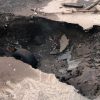Scientists cannot come to a consensus
Scientists confirm that the Earth's core has slowed down so much that it is moving backward. Here's what it could mean. Deep inside the Earth, CNN says, is a solid metal ball that spins independently of our spinning planet, like a top spinning inside an even larger top, shrouded in mystery.
 < span class="article__picture-description" itemprop="caption">Photo: Argonne National Laboratory
< span class="article__picture-description" itemprop="caption">Photo: Argonne National Laboratory
This inner core has intrigued researchers since its discovery by Danish seismologist Inge Lehmann in 1936, and how it moves—the speed and direction of its rotation—has been the subject of years of debate. There is growing evidence that the rate of rotation of the core has changed dramatically in recent years, but scientists still disagree about what exactly is happening and what it means.
Part of the problem is that Earth's the subsurface cannot be observed or sampled directly. Seismologists have gathered information about the movement of the inner core by studying how waves from large earthquakes that reach this area behave. Oscillations between waves of the same strength that passed through the core at different times allowed scientists to measure changes in the position of the inner core and calculate its rotation, CNN reports.
“Differential rotation of the inner core was proposed as a phenomenon in the 1970s and 80s, but seismological data were only published in the 90s,” says Dr Lauren Waszek, a senior lecturer in physical sciences at James Cook University in Australia.
But researchers debated how to interpret these results, “primarily because of the difficulty of making detailed observations of the inner core due to its remote location and the limited data available,” Dr. Wasek notes. As a result, “studies conducted over the following years and decades disagree on the speed of rotation, as well as its direction relative to the mantle,” she added. Some studies have even suggested that the core did not rotate at all.
One promising model, proposed in 2023, described an inner core that had once rotated faster than Earth itself, but now rotates more slowly. For a time, the core's rotation matched Earth's, the scientists said. Then it slowed even more, until the core began to move backwards relative to the layers of fluid that surrounded it.
At the time, some experts cautioned that more data was needed to confirm this conclusion, and now another team of scientists has provided compelling new evidence to support this inner core rotation rate hypothesis. The study, published June 12 in the journal Nature, not only confirms that the core’s growth is slowing, but also supports the 2023 proposal that the slowdown is part of a multi-year trend of slowing and accelerating growth.
The new results also confirm that the rotation rate changes in a 70-year cycle, said study co-author Dr. John Vidale, a professor of earth sciences in the USC Dornsife College of Letters, Arts, and Sciences.
“We've been arguing about this for 20 years, and I think it speaks for itself,” says Dr. Vidale. “I think we are done with the debate about whether the inner core is moving and what its pattern has been over the last couple of decades.”
But not everyone is convinced that the issue has been resolved, and the question of how the slowing down of the inner core whether the core could affect our planet is still an open question, although some experts say the Earth's magnetic field may play a role.
The solid metal inner core, located about 3,220 miles (5,180 kilometers) deep inside the Earth, is surrounded by a liquid metal outer core. The inner core is composed primarily of iron and nickel, and is estimated to be as hot as the surface of the Sun—about 9,800 degrees Fahrenheit (5,400 degrees Celsius).
The Earth's magnetic field acts on this solid ball of hot metal, causing it to spin. At the same time, gravity and the flow of the liquid outer core and mantle exert resistance on the core. Over many decades, these forces cause changes in the core's rotation rate, Vidale said.
The squelching of metal-rich liquid in the outer core generates electrical currents that feed Earth's magnetic field, which protects our planet from deadly solar radiation. Although the direct effect of the inner core on the magnetic field is unknown, scientists previously reported in 2023 that the slower rotation of the core could potentially affect it, as well as slightly shorten the length of the day.
When scientists try to “see through” an entire planet, they typically look for two types of seismic waves: pressure waves, or P-waves, and shear waves, or S-waves. According to the USGS, P waves travel through all types of substances; S waves only travel through solids or extremely viscous liquids.
In the 1880s, seismologists noticed that S waves generated by earthquakes did not travel through the entire Earth, and so they concluded that the Earth's core was molten. But some P waves, after passing through the Earth's core, appeared in unexpected places—the “shadow zone,” as Inge Lehmann called it—creating anomalies that could not be explained. Lehmann was the first scientist to propose that traveling P waves could interact with a solid inner core within a liquid outer core, based on evidence from the great 1929 New Zealand earthquake.
By tracking seismic waves from earthquakes that have passed through Earth's inner core on similar trajectories since 1964, the authors of the 2023 study found that the rotation occurred on a 70-year cycle. By the 1970s, the inner core was spinning slightly faster than the planet. Around 2008 it slowed down, and from 2008 to 2023 it began to rotate slightly in the opposite direction relative to the mantle.
For the new study, Vidale and his co-authors observed seismic waves caused by earthquakes in the same places at different times. They found 121 examples of such earthquakes that occurred between 1991 and 2023 in the South Sandwich Islands, an archipelago of volcanic islands in the Atlantic Ocean east of the southernmost tip of South America. The researchers also studied core-penetrating shock waves from Soviet nuclear tests conducted between 1971 and 1974.
According to Vidale, when the core rotates, it affects the arrival time of the wave. Comparing the travel times of seismic signals as they touched the core revealed changes in the rotation of the core over time, confirming a 70-year rotation cycle. According to the researchers' calculations, the core is about to start accelerating again.
Compared to other seismographic core studies, which measure individual earthquakes as they pass through the core—regardless of when they occur—using only paired earthquakes reduces the amount of data used, “which makes the method more complex,” Lauren Vashek points out. However, Vidale said it also allowed scientists to measure changes in the rotation of the nucleus with greater precision. If his team's model is correct, the core's rotation will begin to accelerate again in about five to ten years.
The seismographs also showed that during its 70-year cycle, the core's rotation slows down and speeds up at different rates, “which requires explanation,” Vidale said. One possibility is that the inner metal core is not as strong as expected. If the core is deformed as it spins, it could affect the symmetry of its spin rate, he said.
The team's calculations also show that the core has different spin rates when moving forward and backward, adding «an interesting contribution to the debate ”, says Vashek.
But the depth and inaccessibility of the inner core means uncertainty remains, she added. As for whether the nuclear rotation debate is truly over, “we need more data and improved interdisciplinary tools to study this issue further,” Vasek said.
Changes in nuclear rotation, although they can be tracked and measured , are virtually invisible to people on the surface of the Earth, Vidale notes. When the core rotates more slowly, the mantle speeds up, causing the Earth to rotate faster, and the length of the day shortens. But, he says, such rotational shifts in the length of the day are only thousandths of a second. .
Scientists are studying the inner core to learn how the Earth's interior formed and how activity throughout the planet's subsurface is connected. The mysterious region, where a liquid outer core surrounds a solid inner core, is particularly interesting, Vidale added. As the place where liquid and solid matter meet, this boundary is “filled with the potential for activity,” as are the core-mantle boundary and the mantle-crust boundary.
“For example, we may have volcanoes on the inner boundary of the core, where solid and liquid meet and move,” he said.
Because the rotation of the inner core affects the movement in the outer core, the rotation of the inner core is thought to contribute to the strengthening of the Earth's magnetic field, although for Further research is required to clarify its exact role. And there is still much to be learned about the overall structure of the inner core, Wasek said: “New and emerging methodologies will play a central role in answering current questions about the Earth's inner core, including the question of rotation.”























































Свежие комментарии